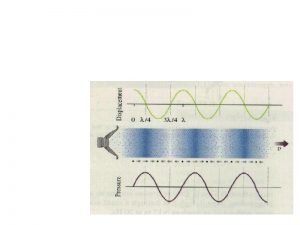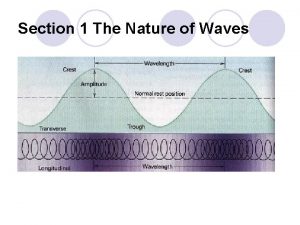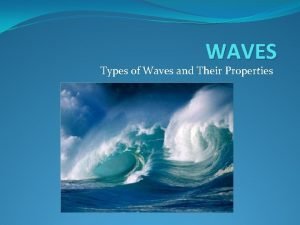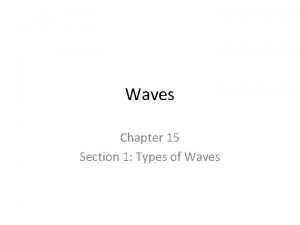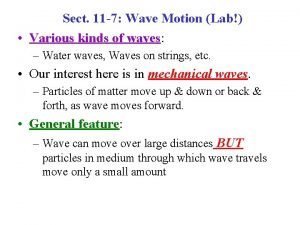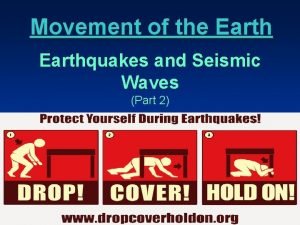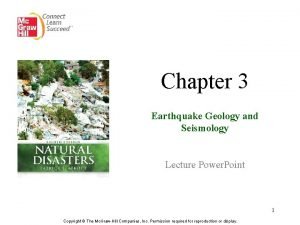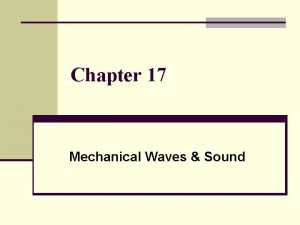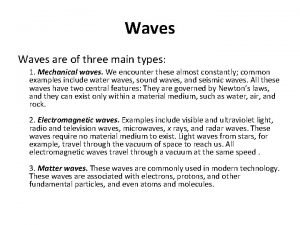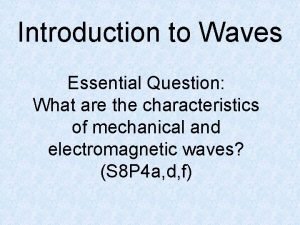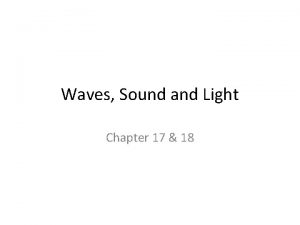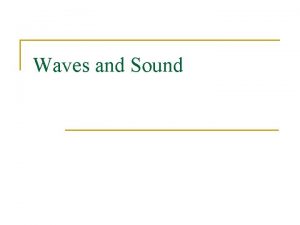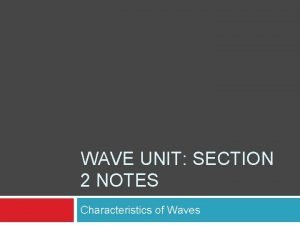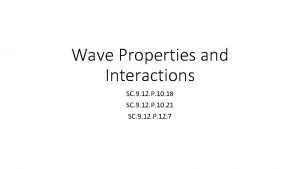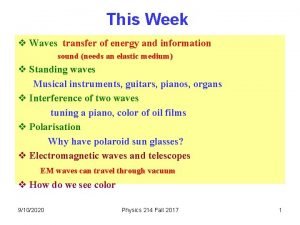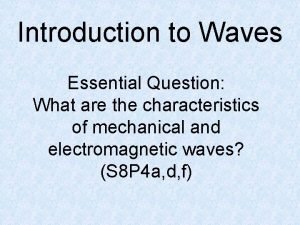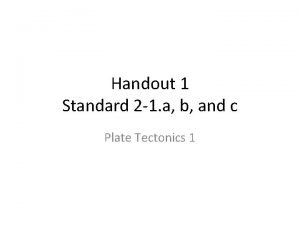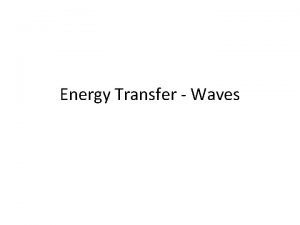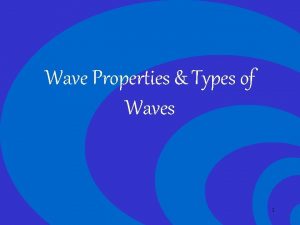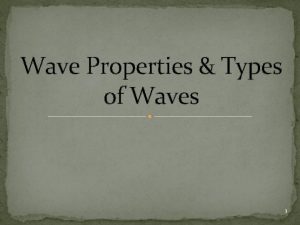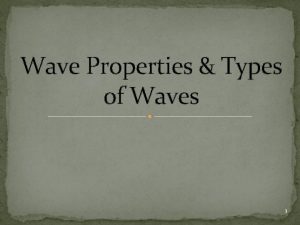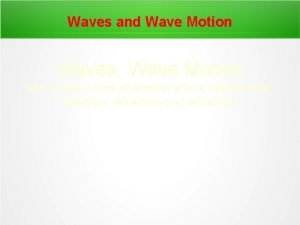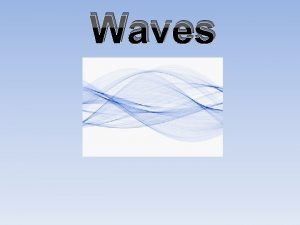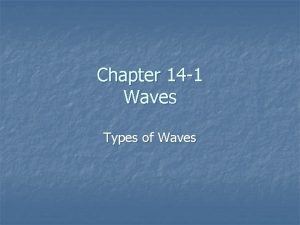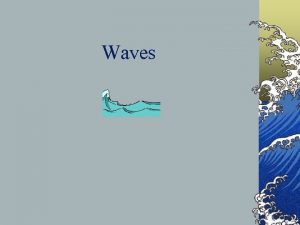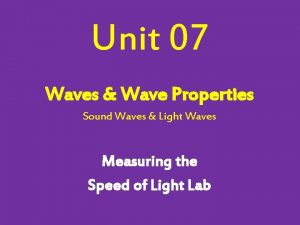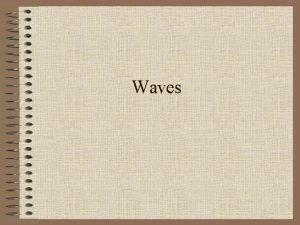Waves v Wave Types v Wave Properties v














































- Slides: 46

Waves v Wave Types v Wave Properties v Wave Interactions v Sound Waves v Properties of Sound

The Nature of Waves What is a wave? A wave is a repeating disturbance or movement that transfers energy through matter or space

Waves transfer energy not matter. The water waves below are carrying energy but are not moving. Waves can only exist if they have energy to carry them.

Mechanical waves are waves which require a medium. A medium is a form of matter through which the wave travels (solid, liquid or gas). Examples: sound, ocean waves, earthquake (seismic) waves…most waves that we normally think of. Electromagnetic Waves such as light, x-rays, and other forms of radiation (as found on the electromagnetic spectrum) do not require a medium.

Mechanical Waves Types: 2 main Types: ØTransverse Wave ØLongitudinal Wave Sometimes these combine to form another kind -- Surface Wave

Transverse Waves In a transverse wave the matter in the wave moves up and down at a right angle to the direction of the wave

Example of a transverse wave: Anything that moves like this


Longitudinal Waves Also known as Compressional Waves In a longitudinal wave the matter in the wave moves back and forth and parallel to the direction of the wave

Longitudinal Waves Sound waves are compressional waves. v Sound travels as vibrations moving through the air as a compressional wave. v Sound travels through air, but travels through other materials as well. Whale communicate through long distances by producing sounds under water.

What are Seismic Waves? An energy wave which vibrates through the earth’s crust as the crust bends or breaks. Seismic waves are exist as both transverse and compressional waves. Some travel through the earth (compressional) and some travel across the earth’s surface (transverse).

What are the parts of a wave? Parts of Transverse Waves The crest is the highest point on a transverse wave. The trough is the lowest point on a transverse wave. The rest position of the wave is called the node or nodal line. The wavelength is the distance from one point on the wave to the next corresponding adjacent point

Parts of Longitudinal Waves or Compressional On a longitudinal wave the area squeezed together is called the compression. The areas spread out are called the rarefaction. The wavelength is the distance from the center of one compression to the center of the next compression.

Wave Properties * Amplitude * Wavelength * Frequency * Wave Speed

What is the amplitude of a wave? The amplitude of a wave is directly related to the energy of a wave as shown by the wave’s height from it’s rest position. Greater energy is required to move the crest of the wave away from its rest position. Amplitude Rest Position Larger Amplitude = Greater Energy!


The amplitude of a transverse wave is determined by the height of the crest or depth of the trough

What is wavelength? Wavelength (λ) is a measure of distance, so the units for wavelength are always distance units, such as meter, centimeters, millimeters, etc.


What is wave frequency? The number of complete waves that are produced or pass through a given point in a certain amount of time. The unit for frequency is waves per second or Hertz (Hz). One Hz = One wave per second.


Wavelength and frequency are inversely related. The smaller the wavelength, the more times it will pass through a point in one second. The larger the wavelength, the fewer times it will pass through a point in one second.

Wave Speed ~ A wave moving through a medium travels at a certain speed. This is Wave Speed. Wave speed is usually measured in meters/second, but may be measured using other distance units (such as centimeters per second). Wave speed is calculated as the product of a waves frequency and wavelength. Wavelength is represented by the Greek letter lambda (λ) and frequency is represented by (f )

The Behavior of Waves When a wave bounces off an object and changes direction – this is reflection.

What is refraction? • Refraction is the bending of a wave as it passes from one medium to another. • A wave travels at different speeds in different things. • When a wave traveling a certain speed moves into another medium, it will either increase in speed or decrease in speed, resulting in a change in direction.



What is diffraction? Diffraction occurs when an object causes a wave to change direction and bend around it.

Diffraction also occurs when passing through a small opening. They diffract and spread out as they pass through the hole.

What is wave interference? Waves interfere in one of two ways: Constructive Interference and Destructive Interference.


What is Resonance? The increase in the amplitude of vibration that occurs when external vibrations match the object’s natural frequency Many objects have a natural frequency – they vibrate in a regular pattern. In music, resonance is the characteristic of sound waves vibrating in either the open air or within the instrument-Like in a violin, when the strings are bowed, the sound resonates within the box (the hollow part of the instrument) and thus becomes a bit more amplified for us to hear.

What is sound? Sound is a compressional wave which travels through the air through a series of compressions and rarefactions.

Sound travels through different media… We hear sound which usually travels through air. Sound travels through other media as well, such as water and various solids. Sound travels different speeds in different media. Sound typically travels faster in a solid than a liquid and faster in a liquid than a gas.

q The denser the medium, the faster sound will travel. q The higher the temperature, the faster the particles of the medium will move and the faster the particles will carry the sound.

Sound Intensity & Loudness Sound intensity is the energy that the sound wave possesses. The greater the intensity of sound the farther the sound will travel and the louder the sound will appear. Loudness is very closely related to intensity. Loudness is the human perception of the sound intensity. The unit for loudness is decibels.

Loudness in Decibels

How is frequency related to pitch? The pitch of a sound wave is directly related to frequency. A high-pitched sound has a high frequency (a screaming girl). A low-pitched sound has a low frequency (a fog-horn).

A healthy human ear can hear frequencies in the range of 20 Hz to 20, 000 Hz. Humans cannot hear below 20 Hz. Sounds below this frequency are termed infrasonic. Sounds above 20, 000 Hz are termed ultrasonic. Some animals, such as dogs, can hear frequencies in this range in which humans cannot hear.

What is the Doppler Effect? The Doppler Effect is the apparent change in frequency detected when the sound is moving relative to the listener. As the sound moves towards the listener, the waves reach the listener with a higher frequency (they are coming faster). The pitch appears to increase…As the sound moves away, the waves reach the listener with a lower frequency -pitch appears to decrease.

Video – Example of Doppler Effect with car horn. (26 seconds) Video – Motorcycle and the Doppler Effect (27 seconds)

Acoustics is the study of sound and ways to optimize the hearing of sound inside various structures.

What is echolocation?


What is sonar? Sonar is a system that uses the reflection of underwater sound waves to detect objects. This has been used to find sunken ships and schools of fish.

~The End ~
 High and low frequency waves
High and low frequency waves Longitudinal vs transverse wave
Longitudinal vs transverse wave Mechanical waves characteristics
Mechanical waves characteristics Difference between mechanical and electromagnetic waves
Difference between mechanical and electromagnetic waves The wave chapter 13
The wave chapter 13 Sound waves longitudinal waves
Sound waves longitudinal waves Carbon dioxide temperature
Carbon dioxide temperature Mechanical waves and electromagnetic waves similarities
Mechanical waves and electromagnetic waves similarities Electromagnetic waves vs mechanical waves
Electromagnetic waves vs mechanical waves Mechanical waves and electromagnetic waves similarities
Mechanical waves and electromagnetic waves similarities Seismic waves
Seismic waves Seismic waves are mechanical waves
Seismic waves are mechanical waves Compare and contrast p waves and s waves using venn diagram
Compare and contrast p waves and s waves using venn diagram Electromagnetic and mechanical waves
Electromagnetic and mechanical waves Differences between constructive and destructive waves
Differences between constructive and destructive waves Properties of waves
Properties of waves Basic properties of waves
Basic properties of waves Detail the measurable properties for all waves.
Detail the measurable properties for all waves. Property of mechanical waves
Property of mechanical waves Properties of mechanical waves
Properties of mechanical waves Properties of mechanical waves
Properties of mechanical waves Magnetostriction method
Magnetostriction method 4 basic properties of waves
4 basic properties of waves Ability of two or more waves to combine and form a new wave
Ability of two or more waves to combine and form a new wave Difference between intensive and extensive properties
Difference between intensive and extensive properties Is smell a physical property
Is smell a physical property Wave types
Wave types The wave chapter 15
The wave chapter 15 Scalar waves
Scalar waves Seismic wave types
Seismic wave types Earthquake
Earthquake Do earthquakes happen
Do earthquakes happen Types if faults
Types if faults Types of mechanical waves
Types of mechanical waves Types of waves
Types of waves Parts of a wavelength
Parts of a wavelength Types of waves quad clusters answer key
Types of waves quad clusters answer key What is mechanical wave
What is mechanical wave Fundamental frequency
Fundamental frequency Longitudinal wave
Longitudinal wave Wavelength parts
Wavelength parts What are the two types of waves?
What are the two types of waves? Types of waves quad clusters
Types of waves quad clusters Define shadow zone
Define shadow zone A wave transfer______without transferring matter.
A wave transfer______without transferring matter. Four types of seismic waves
Four types of seismic waves Wave properties lesson 2
Wave properties lesson 2






















